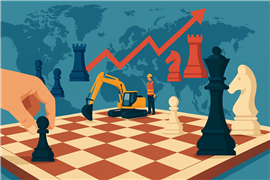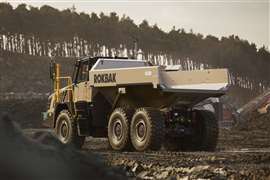Read this article in Français Deutsch Italiano Português Español
Tariffs, tensions and tough choices: how game theory can play to OEMs’ advantage
20 May 2025
 Image generated using AI
Image generated using AI
With trade protectionism on the rise, doing business across borders just got a lot more complicated. With so many variables at play simultaneously, game theory helps provide construction OEMs with the strategic options to thrive, says abcg’s Alan Berger and Maria Metz and Arbalète’s John Jullens and Marc Robinson
We are living in interesting times where the old certainties of international trade are being torn up or seriously rewritten. And the construction equipment industry – far from being immune to the political drama – has found itself at the centre of a shifting geopolitical chessboard. The recent announcement of sweeping new US tariff policies and other countries’ trade policy responses - followed by partial reversals - have thrown supply chains into uncertainty, disrupted investment planning, and increased the cost of doing business. For OEMs and suppliers alike, understanding how these dynamics play out is now essential to identifying flexible strategic options that enable long-term competitiveness.
Enter game theory
Game theory, the science of strategic interactions between stakeholders, provides a powerful lens to anticipate how players — governments, construction equipment OEMs and suppliers —might behave in complex, high-stakes environments. At its core, each game’s outcome is based on three fundamental questions: Who are the players? What are their options? And what do they want? From there, game theory models how each actor is likely to respond to the choices of others, helping leaders ‘look around corners’ and make better decisions in times of uncertainty.
To assess the impact of the Trump administration’s trade moves, we recently built a high-level game theory model encompassing six strategic players: the US administration, Western governments, globally diverse construction OEMs, and key suppliers. We mapped out 25 potential moves across market participants and governments, examined their possible motivations and constraints – and used all this to predict the most likely outcomes. The game was played actually well before President Trump’s announcement of the most sweeping tariff package in US history on what it dubbed ‘Liberation Day’, which only enhances its value as the game’s insights turned out to be highly prescient.
The analysis yielded important insights, divided across short- and long-term timeframes:
Short-Term Impacts: Immediate Reactions and Tactical Shifts
- Tariffs will rise: The Trump administration sees multiple benefits — political and economic — in imposing tariffs and is likely to escalate them. Retaliation by foreign governments is inevitable.
- Policy uncertainty will persist: Tariff levels and trade rules will remain volatile as negotiations evolve and domestic priorities shift, creating operational ambiguity.
- Price adjustments will be swift: Construction OEMs and their suppliers — both foreign and domestic — will rapidly pass through tariff costs. U.S.-based players may also capitalize on new protectionist advantages to expand margin and market share.
- Near-term first-mover advantage Is possible: Companies able to quickly adapt pricing and sourcing may gain an early edge. However, this must be weighed against the risk of recession or sharp policy reversals.
- Limited industry influence: Despite the magnitude of impact, construction industry players will have little sway over trade policy, emphasising the importance of adaptation over advocacy.
Long-term impacts: Strategic realignments and structural change
- Supply chain regionalisation: As tariffs endure, construction OEMs will increasingly re-source components and encourage local production, shifting toward regional supply chains across the US, Europe, and Asia-Pacific.
- Global overcapacity risk: These adjustments will increase capacity without corresponding demand growth, threatening margins and raising the risk of underutilised assets.
- Competitive pressure on supplier capacity: A scramble for domestic supply may spark bidding wars, creating an advantage for those who act early and have strong productive relationships with their suppliers — but potentially at elevated cost.
- Need for operational flexibility: Equipment manufacturers will benefit from production systems that allow fast, low-cost reallocation across regions — a ’no-regret’ investment in a volatile world.
- Expanded service offerings: As unit purchases decline in the face of uncertainty, construction equipment makers will need to pivot toward services that extend the life of existing fleets and create new revenue streams.
Acting on the insight: One game does not fit all
While the high-level game described here offers valuable directional guidance, the real power of game theory lies in its ability to tailor insights to the specific strategic context of each company. Product portfolio, cost structure, geographic footprint and supplier relationships are unique — and so is the game every construction OEM is playing.
Smart companies will invest in custom game theory models that reflect their particular challenges and opportunities. Such models can assess not just the impact of tariffs but also incorporate demand shifts, competitor moves, regulatory developments and geopolitical risk — delivering targeted foresight that informs flexible response strategies and improves decision-making.
In a world of rising trade barriers, policy unpredictability and volatility, resilience and adaptability are not luxuries, but necessities. Game theory can help put construction equipment manufacturers on the winning side.
STAY CONNECTED


Receive the information you need when you need it through our world-leading magazines, newsletters and daily briefings.
CONNECT WITH THE TEAM










